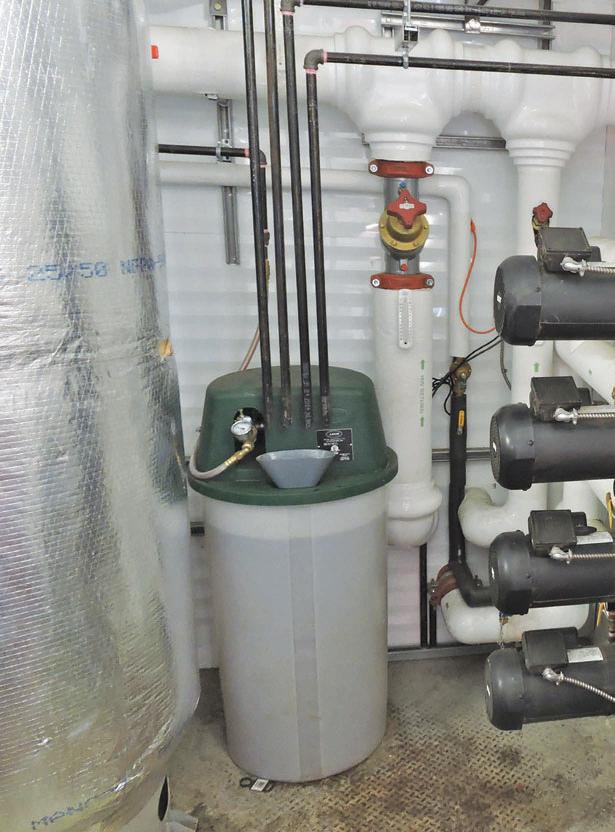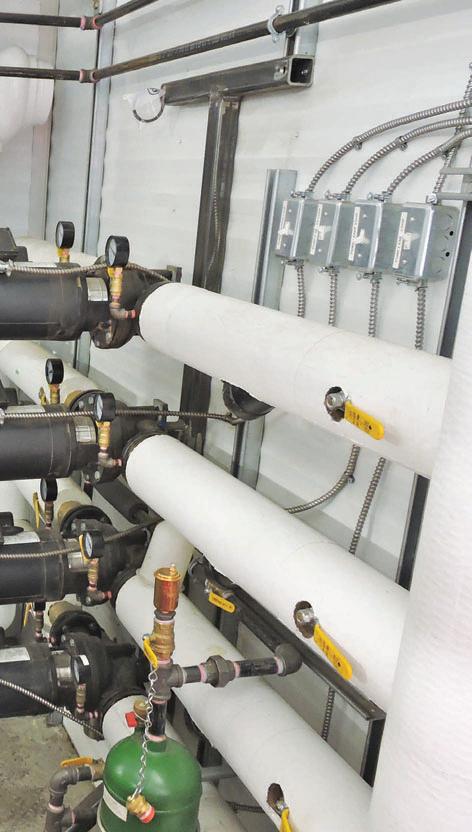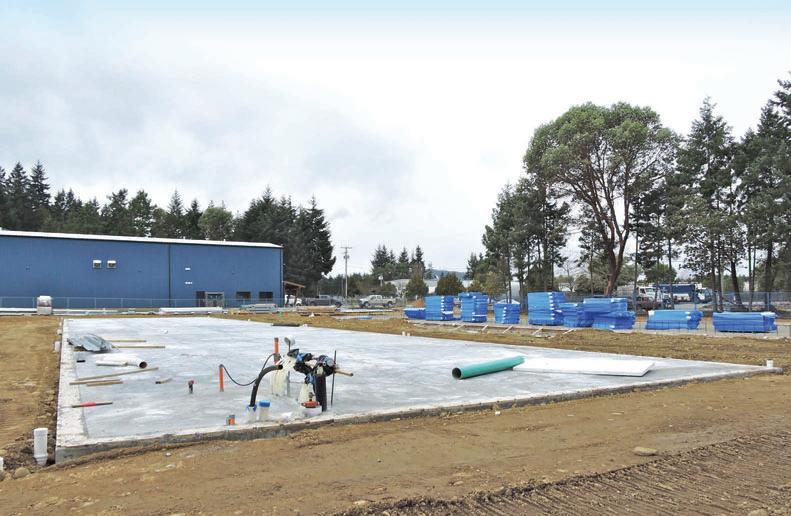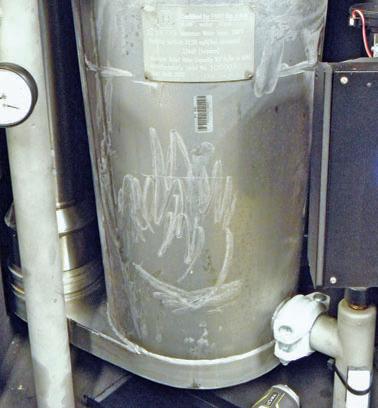
7 minute read
Hydronics
from September 2021
This large feeder was installed in a central biomass heating plant in northern British Columbia.
The most common, and arguably most effective, method of preventing pipes from freezing is with the use of glycol. By Roy Collver
It is a well-known fact that water expands when it freezes. Every component within a hydronic system is subject to rupture or destruction as a result of this fact.
It is sobering to think of the force required to blow apart a malleable iron pipe fitting, cast iron pump, or piece of schedule 40 steel pipe. All of which I have seen firsthand.
We live in cold country where accidental freeze-up of buildings is possible everywhere, even on the balmy West coast. How do we prevent destructive freezing from happening?
Strategically chosen
There are four basic principles when it comes to freeze protection strategies. The first involves the prevention of all hydronic components from reaching temperatures below freezing. To ensure this, every component of the system must be installed within a conditioned space and sufficient backup plans. Equipment must be in place to ensure the space never goes below freezing in the coldest weather during extended power outage situations or mechanical breakdowns.
The second strategy is to drain all the water from the system before any type of freezing occurs. This is a common strategy with some solar thermal system outdoor components, but it requires careful piping design, equipment, and controls to ensure everything will drain out completely.
Keeping the water temperature above freezing and moving it fast enough so it will not freeze in cold sections of piping is the third option for contractors. This must be done even when space heating is not required. Control strategies for opening all zone valves

and running circulators will also be needed with this strategy.
The final strategy is adding anti-freeze chemicals to the water so it will not freeze and expand in the most extreme cold weather conditions even with a major mechanical failure.
In most Canadian climate zones, the first three methods are generally deemed to be just too risky. A control not working, a pump failure, an extended power outage, blocked distribution piping, or faulty design can result in failure. The most foolproof method has proven to be the addition of anti-freeze chemicals.
Types of glycol
In today’s hydronic systems, that means using propylene or ethylene glycol designed specifically for hydronic heating systems. Ethylene glycol has fallen out of favour due to its extremely toxic nature, especially in residential systems where careful monitoring of chemical use and its disposal are
problematic. Propylene glycols for hydronic systems are considered to be non-toxic (the rats and rabbits didn’t die). They perform well down to very cold temperatures and are formulated using other non-toxic inhibitor chemicals. Since plain glycol can break down fairly quickly to produce glycolic acid, inhibitors are added for corrosion protection. Inhibitor chemicals buffer acids, prevent bacterial growth, and adjust pH to metal friendly levels while passivating bare metal surfaces. Unfortunately, one size does not fit all and choosing the right glycol can be complicated.
Speaking of pH levels, a mystery in this department was recently solved. In the last few decades, aluminum components have been introduced to North American hydronics systems. Unfortunately, there have been many failures due to corrosion. Many references detail that the pH of hydronics fluid in systems that contain aluminum are required to be between pH 6.5 and 8.5.

This slab is under a hydrostatic pressure test using pure water. Contractors are cautioned to make sure glycol is added if there is any chance the slab might drop below freezing. Trying to blow all of the water out after the test would be almost impossible.
One size does not
Continued on page “27”
Continued from page “25”
Throwing aluminum into the mix
How do we reconcile that requirement with the fact that the pH of many popular brands of mixed glycol are listed as between 9.0 and as high as 10.5? Alkaline fluids are great for steel and copper but corrosive to aluminum. Some chemical companies do mention this in their literature and can provide a special inhibitor that will help protect aluminum, but is their stuff compatible with the glycol solutions you are using? Where do we go to for advice on this?
Here are two descriptions of inhibitors I found whilst reading manufacturer’s literature: a) “Specially formulated packages of industrial inhibitors that help prevent corrosion;” and b) “a complex multi-metal inhibitor package.”
Not exactly revealing the nature or contents of their secret sauces. Being curious by nature, I just had to dig down a bit on behalf of my similarly snoopy readers. Reading through the MSDS sheet for product (a), a 50 per cent propylene glycol product, gave me the following ingredient list by weight: 1) Propylene glycol (less than 48 per cent to more than 54 per cent) 2) Water (more than 50 per cent) 3) Dipotassium hydrogen phosphate (more than three per cent) 4) Aqueous additives (more than two per cent) further described as “confidential performance additives.”
So close! In a normal system containing a single product, these chemical manufacturers know their stuff. We do know that it is not recommended to mix different chemicals from two suppliers in the same system without checking with both manufacturers for their assurance of compatibility.
Clean and flush the system
This leads me to a few important points to keep in mind. Firstly, always clean and flush a new system prior to filling it with fresh glycol solution. Make sure to leave technical data sheets, maintenance/testing information, and supplier name and contact information in a readily accessible location for the owner and future technicians to reference. I’d suggest a recommended service interval where you will come back to test and adjust the heating fluid – a reminder card is a great idea. Do not leave extra glycol or mix behind unless you personally discuss it with the owner and ensure it is stored safely in a clearly labeled container.
When topping up a system to replace lost glycol, make sure to use the same product that is already in the system. If you don’t know what is already is installed – drain, clean, flush, and start over to avoid this in the future. Proper disposal of used heating system fluids is the responsibility of the contractor and shouldn’t be dumped in storm or sanitary sewers, on the ground, or in bodies of water.
It is often difficult to find out where to dispose of this stuff. For those in the hydronics business, I’d suggest doing some research ahead of time and find out where to take it. Also, document the associated disposal fees to justify an enviro-disposal charge to add to your bill. Advise your customer prior to draining and be prepared to pack up your tools if they object to paying the fee.
It should also be noted that there are minimum and maximum recommended concentrations of glycol in solution and special glycol mixes for specific applications. For all practical purpose, 50 per cent glycol is considered the maximum dose in residential and light commercial systems. Solutions of less than 30 per cent glycol lack sufficient inhibitor protection and should have their inhibitor levels adjusted – contact the manufacturer for their requirements and procedures for testing the inhibitors.
Different applications
For glycol solutions intended for use in geoexchange systems, they are typically pre-mixed with inhibitors designed to work at 20 per cent glycol. Solar thermal glycol solutions are specially designed with inhibitors and stabilizers to stand up to the extreme high temperatures often found in stagnant solar panels and need more frequent testing.
Glycol increases fluid viscosity and reduces heat transfer and heat carrying capacity. The system designs need to be adjusted to take these factors into account. Make sure to use treated water when you must mix solutions on-site, or better yet, purchase pre-mixed glycol solutions.
To be more efficient, I’d suggest purchasing or building a flush-and-fill cart. You can also use a glycol feeder tank instead of all the freshwater feed PRV and backflow gear. ✚

Using the “glycol freeze” method does work for plumbers in a pinch; simply draw a sample of water from the boiler and stick it in the freezer. In this case, it is clear there isn’t enough glycol protection. Without glycol, this gas condensing boiler would be destroyed as it is subject to freezing temperatures from time to time.

Roy Collver is an author and consultant on hydronic heating based in Qualicum Beach, B.C. He can be reached at
hoth2o@shaw.ca











